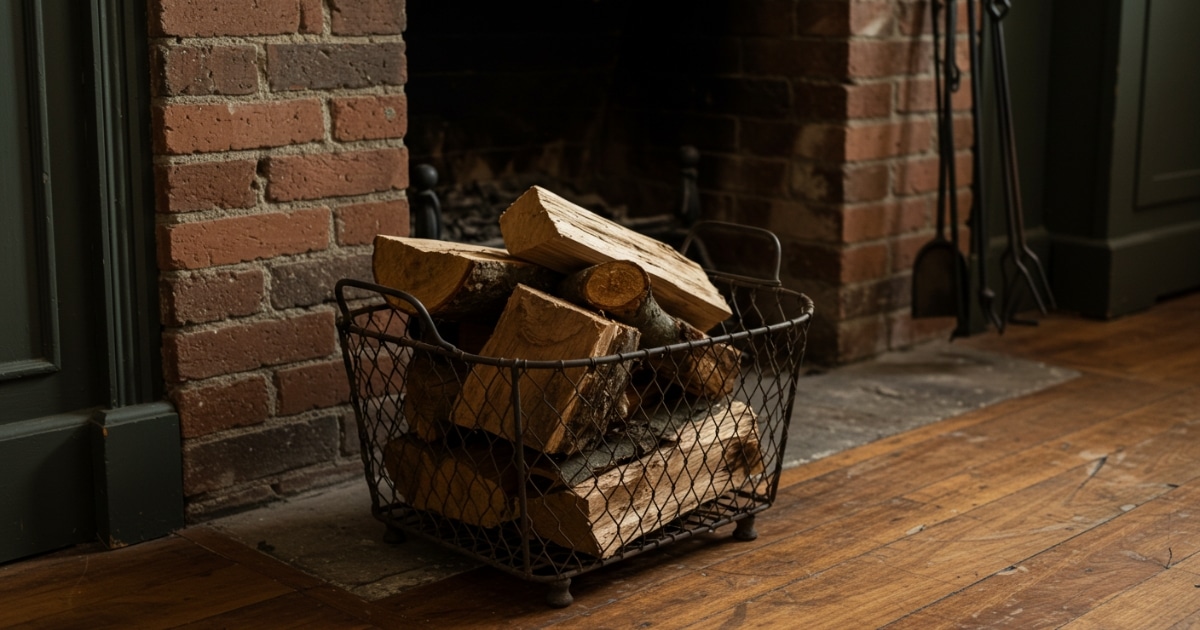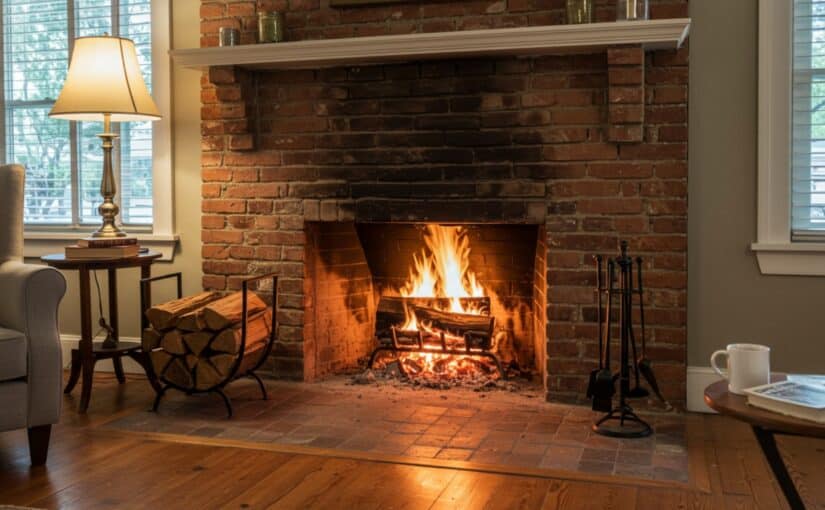When winter’s chill sets in, a roaring fire offers warmth, ambiance, and comfort. But did you know that the best firewood for fireplaces is about safety, efficiency, and even environmental impact? Whether you’re a seasoned fireplace user or lighting your first winter blaze, understanding the differences between hardwoods, softwoods, and seasoned wood can make all the difference.
At A Noble Sweep, we’ve spent over 30 years helping homeowners in the Greater New Orleans area maintain safe and efficient fireplaces. While we don’t sell firewood, our chimney maintenance and fire safety expertise means we’ve seen firsthand how wood choice impacts performance. From creosote buildup caused by green wood to the dangers of burning treated materials, we’ve helped countless families create safer, more enjoyable fireplace experiences.
In this guide, we’ll share everything you need to know about selecting the best wood for your fireplace, including why seasoned hardwood is a top choice, the risks of burning green wood, and how proper storage can enhance your fires. Let’s dive into the details so you can enjoy a safe, warm, and crackling fire all season long.
Key Takeaways
- Hardwoods are the top choice for long-lasting heat and minimal creosote buildup.
- Softwoods are suitable for kindling but should not be used as the primary firewood.
- Only seasoned wood should be burned to ensure efficient combustion and reduced smoke.
- In Louisiana, transporting uncertified firewood across certain areas is restricted due to pest infestations and environmental concerns.
- Avoid certain types of wood, such as treated, painted, or driftwood, to prevent toxic emissions.
Why Choosing the Right Firewood Matters
The type of firewood you burn directly affects the quality and safety of your fireplace experience. Selecting the best firewood for fireplaces ensures you get the most out of your fires while protecting your home and the environment.
Heat Efficiency
Not all firewood burns the same. Dense woods, like oak and hickory, burn longer and hotter, providing sustained heat and making them ideal for warming your home during cold winter nights. In contrast, lighter woods, such as pine, ignite quickly but burn out faster, requiring more frequent refueling.
Safety Considerations
Burning the wrong type of wood can lead to dangerous creosote buildup in your chimney. Creosote is a highly flammable residue that accumulates when wood burns incompletely, often due to high moisture content or resin-heavy softwoods. Over time, it increases the risk of chimney fires, making regular chimney sweep services and fireplace inspections essential.
Environmental Responsibility
Using seasoned hardwoods helps minimize the environmental impact of your fires. Properly dried wood produces less smoke and fewer particulates, leading to cleaner air. Moreover, sourcing your firewood locally, as recommended in Louisiana, prevents the spread of invasive pests like emerald ash borer and reduces the carbon footprint associated with transportation.
By understanding the impact of your firewood choices, you can enjoy warm, inviting, and safe fires for both your home and the environment. At A Noble Sweep, we know that selecting the right firewood is as important as maintaining a clean and functional chimney. One key aspect of firewood selection is understanding the differences between hardwoods and softwoods—let’s take a closer look at why this distinction matters for your fireplace.

Understanding the Types of Firewood
Choosing the right firewood means knowing the differences between hardwoods and softwoods and understanding the importance of properly seasoned wood.
Hardwoods: Long-Lasting and Efficient
Oak: The Heavyweight Champion
- Burns hot and slow, ideal for prolonged warmth
- High heat output, perfect for cold winter nights
- Dense wood that can be challenging to split but rewards with long-lasting fires
Hickory: The Aromatic Powerhouse
- Provides consistent, intense heat
- A pleasant, bacon-like aroma enhances the fireside experience
- One of the densest firewoods, offering excellent cooling properties
Ash: The Versatile Performer
- Lights easily and burns steadily
- Unique ability to burn well even when slightly green
- Lower moisture content than other hardwoods, seasoning faster
Maple and Cherry: The Steady Flames
- Produce bright, steady flames for a cozy atmosphere
- Easy to split, making preparation less labor-intensive
- Cherry offers a subtle, sweet aroma when burned
Softwoods: Quick and Intense
Pine: The Quick Starter
- Lights quickly, ideal for initiating fires
- Burns fast and hot due to high resin content
- Caution: Can contribute to creosote buildup, best used sparingly
Cedar: The Aromatic Kindling
- Highly aromatic, adding a pleasant scent to your home
- It is ideal for kindling or fire starters due to its easy ignition
- Produces a crackling sound and bright flames
Poplar and Fir: The Short-Term Heat
- Burn quickly, best for short-term fires or starting a blaze
- Light in weight, making them easy to handle and split
- Produce moderate heat, suitable for mild days or quick warmth
Seasoned Wood vs. Green Wood
- Seasoned Wood: This wood is carefully dried for 6-12 months to reduce its moisture content below 20%, making it ideal for burning. This low-moisture wood generates more heat, produces minimal smoke, and significantly reduces creosote buildup in chimneys. Burning seasoned wood will give you cleaner, more consistent flames and improve your fireplace’s efficiency and performance.
- Green Wood: Green, fresh wood contains too much moisture, making it a poor choice for fireplace burning. It generates excessive smoke, produces minimal heat, and creates substantial creosote deposits, increasing the risk of chimney fires. Burning green wood reduces fireplace efficiency, contributes to environmental pollution, and can potentially cause respiratory irritation.
Local and Safe Sourcing in Louisiana
Transporting uncertified firewood out of quarantined areas is prohibited due to pests such as the emerald ash borer and imported fire ants. To support local ecosystems and mitigate the spread of invasive species, it is always advisable to purchase firewood locally, ideally within 10 miles of where it will be burned.
By choosing high-quality hardwoods, avoiding green wood, and following local firewood guidelines, you’ll create a fireplace experience that is safe, efficient, and enjoyable. At A Noble Sweep, we’ve seen how these choices directly impact fireplace performance and safety. One of the most critical factors we emphasize is the use of properly seasoned wood, which plays a vital role in reducing creosote buildup, enhancing heat output, and ensuring a cleaner burn. Let’s explore why seasoned wood is essential for your fires.

The Importance of Seasoned Firewood for Fireplaces
Seasoned wood is essential for efficient and safe fires. By drying wood to reduce its moisture content to 20% or less, you ensure it burns hotter, produces less smoke, and minimizes creosote buildup in your chimney. This makes your fireplace more effective and significantly reduces the risk of dangerous chimney fires. Properly seasoned wood lights quickly, burns consistently, and provides steady warmth, making it a reliable choice for your home.
If you’re preparing your own firewood, the seasoning process is straightforward. Start by splitting logs into smaller pieces to speed up drying. Stack the wood in a single row to maximize airflow, and protect the top of the stack with a tarp, leaving the sides open for ventilation. With these steps, your firewood will be ready to burn in 6–12 months, depending on the type of wood and local climate.
Woods to Avoid in Your Fireplace
Not all wood is suitable for burning. Green or wet wood, for example, contains high moisture, which produces steam and excessive smoke instead of warmth. This leads to more creosote buildup, increasing fire hazards. Similarly, treated or painted wood releases toxic chemicals when burned, making it unsafe for indoor use. Driftwood, often saturated with salt, can also emit harmful pollutants, while construction scraps and cardboard are treated with chemicals unsuitable for combustion. Stick to seasoned, untreated hardwoods for the safest and most efficient fires.
Storing Firewood for Fireplaces the Right Way
Proper storage is crucial for maintaining dry and pest-free firewood. Always elevate your wood stack using pallets, concrete, or gravel to prevent moisture from seeping in. Cover the top layer with a tarp to shield it from rain, but ensure enough ventilation to allow the wood to dry further. Only bring inside the amount of wood you plan to burn immediately to avoid attracting pests. With these precautions, your firewood for fireplaces will be ready to fuel a warm, crackling fire all season.
Enhancing Your Fireplace Experience
Creating the perfect fire is as much about technique as the wood itself. Start with softwoods for quick ignition, then transition to hardwoods for long-lasting heat. Consider upgrading to modern fireplace inserts or gas stoves to improve efficiency and reduce maintenance needs. Don’t forget to schedule regular chimney sweeps and inspections with A Noble Sweep to ensure your fireplace stays in peak condition.
By choosing seasoned wood, storing it properly, and maintaining your fireplace, you can enjoy cozy fires all winter while keeping your home safe and efficient.

Closing Thoughts: Burn Smart with A Noble Sweep
Choosing the right firewood for fireplaces is more than just a matter of convenience—it’s about ensuring your fireplace’s safety, efficiency, and longevity. By prioritizing seasoned hardwoods, avoiding unsuitable materials, and adhering to local firewood guidelines, you can enjoy cozy fires that warm your home and protect your family.
At A Noble Sweep, we’ve spent decades helping homeowners maintain safe and efficient fireplaces. While the firewood for fireplaces you choose is crucial, regular chimney maintenance is equally important to prevent creosote buildup and other hazards. Our team of certified professionals is here to provide expert chimney sweeps, installations, and repairs, ensuring your fireplace remains a safe and reliable centerpiece in your home.
Don’t let unsafe practices or poor maintenance compromise your fireplace’s warmth and charm. Contact A Noble Sweep today to schedule a chimney inspection or cleaning, and let us help you burn smart this winter.
FAQs: Your Burning Questions Answered
Q: Can I burn any type of wood in my fireplace?
A: No, stick to seasoned, untreated hardwoods like oak or hickory. Avoid green wood, treated wood, driftwood, and construction scraps, as they can produce excessive smoke, creosote buildup, or release harmful toxins.
Q: How can I tell if firewood is correctly seasoned?
A: Seasoned firewood has visible cracks at the ends, feels lighter in weight, and produces a hollow sound when tapped. It’s also stored in a dry, well-ventilated area for at least 6–12 months to reduce moisture content.
Q: What are Louisiana’s firewood transport restrictions?
A: Transporting uncertified firewood out of quarantined areas is prohibited to prevent the spread of invasive pests like emerald ash borer. To comply with local guidelines, source firewood locally, ideally within 10 miles of where you’ll burn it.
Q: How often should I clean my chimney?
A: If you use your fireplace heavily, at least once a year, or more frequently. Annual cleanings reduce creosote buildup and help prevent chimney fires.
Q: Why is seasoned hardwood the best firewood for fireplaces?
A: Seasoned hardwood burns longer, produces more heat, and generates less smoke and creosote than green wood or softwoods. It’s the safest and most efficient choice for indoor fireplaces.
By choosing the right wood and following these guidelines, you can enjoy a safe, efficient, and cozy fireplace experience this winter. For expert chimney inspections and cleaning services, trust A Noble Sweep to keep your fireplace in top condition.

